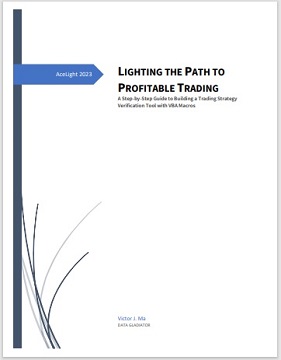Stock Trading Strategies: Short Term vs Long Term
|
|
Welcome, fellow financial adventurers! Today, we're going to explore the
mysterious and often terrifying world of stock trading. It's like playing
the lottery, but instead of scratching off a ticket, you get to watch
numbers on a screen go up and down. Exciting, right? Well, fear not, my
friends, because with the right strategies and a little bit of luck, perhaps
you too might become a millionaire and retire to your own private island (or
at least buy a really nice hat). So, grab your lucky rabbit's foot and let's
dive in!
When it comes to investing in the stock market, there are
two main strategies: short-term and long-term. Short-term trading involves
buying and selling stocks in a relatively short period, usually within a few
days or weeks. Long-term trading, on the other hand, involves holding onto
stocks for a much longer period, usually several years or even decades. In
this blog, we will compare and contrast these two strategies, examining the
advantages and disadvantages of each.
Short-term trading:
Short-term trading is all about making quick profits. It involves buying
stocks and then selling them after a relatively short period, usually within
a few days or weeks. Short-term traders often use technical analysis to
identify stocks that are likely to increase in value in the short term,
based on trends, patterns, and other indicators. Some of the advantages of
short-term trading include:
1. High potential for profit: Short-term
traders can make significant profits in a relatively short period,
especially if they are skilled at identifying profitable trades.
2.
Flexibility: Short-term traders can easily adapt to changing market
conditions, taking advantage of fluctuations in stock prices.
3. Low risk
exposure: Because short-term traders only hold onto stocks for a short
period, their risk exposure is lower compared to long-term traders.
Here are some examples of short-term stock trading strategies:
1.
Scalping: This strategy involves making multiple trades within a single day,
taking advantage of small price movements to generate profits.
2. Day
trading: Day traders buy and sell stocks within a single day, trying to
profit from short-term price fluctuations.
3. Momentum trading: This
strategy involves buying stocks that have shown strong upward momentum in
the short-term, hoping to capitalize on the continuation of the trend.
4.
Swing trading: Swing traders hold onto stocks for a few days or weeks,
looking to profit from short-term price movements.
5. Technical analysis:
Technical analysis involves using charts and other tools to analyze past
price and volume movements, helping traders to identify short-term trading
opportunities.
6. News trading: This strategy involves buying or selling
stocks based on news events, such as earnings announcements or macroeconomic
data releases.
It's worth noting that short-term trading strategies
are generally more suited to experienced traders who have a strong
understanding of market dynamics and risk management. Short-term trading can
be highly profitable, but it's also associated with high levels of risk and
volatility, so traders must be able to manage their risk exposure
effectively.
However, short-term trading also comes with several
disadvantages, including:
1. High volatility: Short-term trading is
highly volatile, and stock prices can fluctuate rapidly, making it
challenging to predict future market movements.
2. High transaction
costs: Short-term trading involves buying and selling stocks frequently,
which can lead to high transaction costs, including brokerage fees and
taxes.
3. Greater risk of losses: Short-term traders may incur
significant losses if they make poor investment decisions or fail to manage
their portfolios effectively.
Long-term trading:
Long-term
trading involves holding onto stocks for a much longer period, usually
several years or even decades. Long-term traders are more concerned with the
fundamental aspects of a company, such as its financial performance,
management, and growth potential. Some of the advantages of long-term
trading include:
1. Lower transaction costs: Long-term traders tend to
buy and hold onto stocks for an extended period, reducing transaction costs.
2. Less volatility: Long-term traders are less affected by short-term market
fluctuations, as they are focused on the long-term potential of a company.
3. Compound interest: Long-term traders can benefit from compound interest,
which can lead to significant gains over time.
Here are some examples
of long-term stock trading strategies:
1. Buy and hold: This strategy
involves buying quality stocks and holding onto them for an extended period,
sometimes even for several years or decades, with the expectation of earning
significant returns over the long term.
2. Value investing: This strategy
involves identifying undervalued stocks based on fundamental analysis and
holding onto them for the long term until their true value is recognized by
the market.
3. Dividend investing: This strategy involves investing in
companies that pay regular dividends to shareholders, providing a steady
source of income over the long term.
4. Growth investing: This strategy
involves investing in companies with strong growth potential, such as
emerging technologies or industries that are expected to experience
significant growth in the coming years.
5. Index fund investing: This
strategy involves investing in low-cost index funds that track the
performance of the overall stock market, providing exposure to a diversified
portfolio of stocks over the long term.
It's worth noting that
long-term investing requires patience, discipline, and a long-term
perspective. Long-term investors should focus on investing in high-quality
companies with strong fundamentals and a long-term growth outlook. While the
returns from long-term investing may be lower in the short-term, they tend
to be more stable and consistent over the long term, providing investors
with a reliable source of wealth creation over time.
However,
long-term trading also has its disadvantages, including:
1. Slow
returns: Long-term trading requires patience, as it may take several years
to see a significant return on investment.
2. Limited flexibility:
Long-term traders may miss out on short-term market opportunities, as they
are focused on a long-term investment strategy.
3. High risk exposure:
Long-term traders are exposed to higher risk than short-term traders, as
they are holding onto stocks for a more extended period.
In
conclusion, whether you're a short-term trader looking to make a quick buck,
or a long-term investor looking to build wealth over time, it's important to
remember that the stock market is a complex and unpredictable beast. So,
before you dive headfirst into the world of stock trading, make sure to do
your research, understand your risk tolerance. Just remember the wise words
of Warren Buffett: “Risk comes from not knowing what you're doing.”
When it comes to stock trading, testing and verification are crucial. It
doesn't matter if you're a short-term trader or a long-term investor; you
need to have a proven strategy that you can rely on.
The problem is
that many people simply take a guess when it comes to trading. They read a
few articles, follow a few influencers on social media, and then jump right
in, hoping to make a quick profit. But this is not the way to approach stock
trading.
Without proper testing, any trading strategy is essentially
a guess. It's like throwing darts blindfolded and hoping to hit a bullseye.
And that's a dangerous game to play with your hard-earned money.
But
what do we mean by "proper testing"? Well, there are two types of testing
that are essential for any trading strategy: back-testing and
forward-testing.
 Backtesting
involves using historical data to simulate how a particular trading strategy
would have performed in the past. This allows you to evaluate the strategy's
strengths and weaknesses and determine whether it's likely to be successful
in the future. Backtesting
involves using historical data to simulate how a particular trading strategy
would have performed in the past. This allows you to evaluate the strategy's
strengths and weaknesses and determine whether it's likely to be successful
in the future.
Forward testing involves testing your trading strategy
in real-time, but with a small amount of money or even virtual funds in a
demo account. This allows you to see how the strategy performs in a live
market environment without risking significant losses.
By properly
testing and verifying your trading strategy, you can significantly increase
your chances of success. But without testing, you're essentially gambling
with your money, and that's never a good idea. For more details,
Click
LIGHTING THE PATH TO PROFITABLE TRADING: A Step-by-Step Guide to Building a Trading Strategy Verification Tool with VBA Macros to get the whole tutorial handbook for free!
And click Free Trial to download strategies testing tools, all for a 30-day Free Trial.
Click on Subscription to order more strategies testing tools to help your stock trading.
If you're looking to get rich quick, stock trading might not be the
best option. But if you're willing to put in the time, effort, and
occasional sacrifice of a goat to the stock market gods, who knows what kind
of returns you might see. Just remember, it's not about the destination,
it's about the journey, and the journey of stock trading is like a
rollercoaster ride with no seatbelts. So, hang on tight and don't forget to
scream!
|


|

Free Tutorial
Share
|
|
|
|